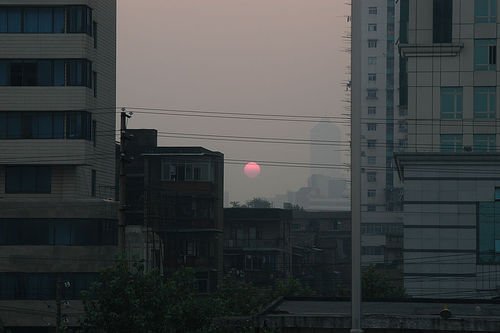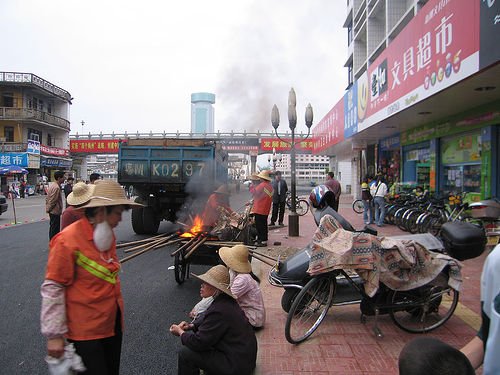Cowboy trousers and the cosmology of denim in China
When Mao Zedong became head of the newly formed People’s Republic of China in 1949 he resisted pressure from his chief of protocol to don a suit and black leather shoes as expected of world leaders, instead opting for a blue tunic and trousers (Finnane 1996:99). The ‘Mao suit’, as it is called in the West, came to be viewed within China as a representation of the country’s independence from the rest of the world, while to the West it became a symbol of cultural homogeneity imposed by the socialist state.

The prevalence of blue denim in today’s China is a marked contrast to the Mao suits worn by its population during the years of the Cultural Revolution. This project will investigate the hypothesis that if the Chinese cosmology of movement is related to a system that lies between the static and the dynamic, then the trajectories of clothing in (a) the denim commodity chain; and (b) the historical evolution of the fabric in relation to the earlier ‘Mao suit’ will be dictated by strategies of a setup and its efficacy. In addition to illuminating traditionally studied areas such as ethnicity, nationality and gender from a material culture perspective it will provide a space for unexplored divisions to be made apparent, and contribute to an understanding of denim as a global fabric. Ultimately it seeks to use this case to explore the Chinese cosmology of movement.
This project, which is dependant on funding, is intended ultimately to contribute to anthropological studies of cosmology, and lived practice as anthropology’s analogy to conventional philosophy. The route it plans to explore is to seek to advance a theory of movement as a means of understanding societies, addressing the philosophical question of what is movement? How does the modern clothing industry encompass Eastern (Buddhist, Daoist) philosophies of movement as the antithesis to stillness, and stillness being essential to enlightenment; with the Chinese communist work ethic as the route to building an harmonious society?
Sinologist and philosopher Françoise Jullien (1995:15) provides the basis of this notion of efficacy in his analysis of the Chinese term shi. He posits that Chinese thought interprets reality solely on the basis of itself, founded on the logic that exists in the processes of motion. Chinese art and wisdom lies in the calculated exploitation of the propensity that emanates from a particular configuration of reality to the maximum effect. Jullien exemplifies this in the successful general who conducts his war from a distance, simply by exploiting the factors in play. This research speculates that such a strategy can be observed in denim consumption in everyday life.

The ubiquitous nature of jeans (niuzaiku, literally ‘cowboy trousers’) in China means that by adopting a commodity chain approach in investigating the hypothesis we fully expect to revisit oft-considered themes in the anthropology of China, such as gender, ethnicity, nationhood and rural-urban inequality, but uniquely movement in the denim commodity chain will act as a prism through which Chinese society is refracted, making unexplored divisions, power structures, economic systems and cultural practices visible.
A prime example of one of the questions raised by the appropriation of denim can be given in the widespread adoption of tight-fitting jeans by young women in China (Ho, 2003). In this mode of denim adoption are we seeing the material realisation of what has been called “China’s Great Sexual Leap Forward” (Zhang, 4 November 2007)? By exploring how consumers and retailers exploit strategies of setup and efficacy in the buying and wearing of denim, a new perspective on the means by which gender roles are played out through clothing will be reached.
China’s denim industry is undergoing rapid growth in the country’s South, with Hong Kong as a major point of trade (Li, Yao and Yeung 2003). In addition to international export, researchers often ignore the considerable proportion of denim intended for domestic use. Here the opportunity exists to understand how the Chinese cosmology of movement affects such growth.
The theory of shi provides a useful starting point with which to explore the relationship of the body to these systems of movement. By approaching this issue through the cosmology of denim it is envisaged that an insight into how movement acts upon the body, and how the body acts to create, control and regulate movement may be achieved, contributing to our understanding of phenomenological experience.

Bibliography
Finnane, A. 1996. What Should Chinese Women Wear? A National Problem. Modern China, 22:2, pp 99-131.
Ho, J. 2003. From Spice Girls to enjo kosai: formations of teenage girls' sexualities in Taiwan. Inter-Asia Cultural Studies, 4:2, pp 325-336.
Jullien, F. 1994. The Propensity of Things: Towards A History of Efficacy in China. New York: Zone Books.
Li, Y., Yao, L. & Yeung, K.W. 2003. The China and Hong Kong Denim Industry. Cambridge: Woodhead Publishing.
Leslie, D. & Reimer, S. 1999. Spatializing commodity chains. Progress in Human Geography, 23:3. pp. 401-420.




 However, China’s main problem is that most of its growth is fuelled by coal. Within a few months, its emission of greenhouse gases will exceed that of America: in 25 years, if left unchecked, it will be
However, China’s main problem is that most of its growth is fuelled by coal. Within a few months, its emission of greenhouse gases will exceed that of America: in 25 years, if left unchecked, it will be 



